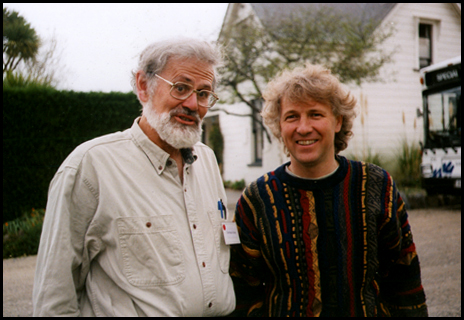 |
Mythology of Place - Homage to James K Baxter - © 1993-94 - Lloyd Godman - Lawrence Jones
THE
MAKING OF 'THE MYTHOLOGY OF PLACE'
Lawrence
Jones
This
project began as an idea for a brief paper to be given at
the James K. Baxter conference in Dunedin in August 1994.
In various walks along the beach and the river road with a
friend who had grown up with Baxter, I had noticed how the
names she used for places - 'The Giant's Grave', 'Pulpit Rock'
-- had chimed in my memory with places named in the Baxter
poems. A picnic at Tunnel Beach established some further
connections. After all, I did live in a house of Bedford
Parade across the street from the Baxter family home, and
Baxter's Brighton had very much become my adopted home.
Why shouldn't I write about Baxter's use of the place? So
I began browsing the Collected Poems for Brighton and other
Otago places and realised there was a lot of material there.
As I worked, I had the thought that it would be good to have
some slides and photographs to illustrate these places, and
I asked my friend and Brighton neighbour Lloyd Godman if he
would be interested in taking the photographs, especially
as I remembered the photographs he had done for Frank McKay's
life of Baxter. I envisaged a few Saturday expeditions
in and around Brighton, and perhaps to Central Otago.
However, as we got to work on the images, the project became
more complex and ambitious. For one thing, the appropriate
places were not always that easy to identify or to reach.
Soon I found myself watching from a less precarious spot on
Big Rock as Lloyd gained the 'difficult security' (Baxter's
phrase) of the cave overlooking the Bay and took his memorable
sequence of photos; or trying out my very uncertain tramping
skills inching across the bluff above an East Matukituki River
in semi-flood, on the way to the Aspiring Hut where Baxter
had written 'Poem in the Matukituki Valley'; or scrambling
up a hillside at the head of the Otago Peninsula to get a
view across the harbour mouth to Aramoana, as a fog bank gathered
outside the harbour but did not yet enter it; or sloshing
by a muddy track to Duffy's Farm, led by a long-time resident
who used to visit the Duffys, all of us aware that there had
been a spectacular murder recently at the shed built on the
site of Duffy's old house; or standing in the rain on Scrogg's
Hill looking down at the flooded Taieri Plain, just as Baxter
must have seen it. The project was both less simple
and more exciting than I had anticipated.
Something else that I should have anticipated but did not
was what happened in the process of taking the pictures.
For soon it became evident to me that these were not going
to be mere 'illustrations'. In searching out Baxter's
places and symbols, Lloyd was finding his own symbols in the
landscape, complementary to Baxter's. The images that
emerged were not illustrations but rather were works of art
inspired by Baxter's works of art, as so much art is in part
a response to other art. The fallen pear tree, the bent metal
rod in the wild landscape, the broken platform in the foreground
with Baxter's feared and respected mountains and glaciers
in the background, the cross emerging from the wild river,
the shape of the roof of Baxter's upstairs room on Bedford
Parade seen as echoing the shape of Scroggs Hill behind it,
the discarded crown of thorns of the seaweed on the beach
in front of the 'Prometheus' rocks -- these were not symbols
from the poems themselves, but they were consonant with them.
As Baxter had done, Lloyd was finding his own symbols in the
landscape. It was a thrill and a pleasure to see the
prints emerge from the process, to see these works of art
taking shape.
Thus when it was time for the conference, the slides were
there for my talk, but also the meeting room for most of the
sessions had screens around the edges bearing the large prints
of the Baxter photos that are now in the Hocken Library. We
were surrounded by Baxter's Otago, and those images established
a tone for the conference.
The conference was a climax of the process, but for me not
the end. In the month following the conference I explored
the unpublished materials in the Baxter papers at the Hocken,
looking for a few more poems to fit into the argument, and
I found tremendous riches -- poems, talks, essays, reviews,
supplying surprising and gratifying confirmation and extension
of some of my readings. The earlier versions and related
unpublished poems surrounding 'Tunnel Beach', for example,
supported and enriched my reading of the symbolism of
that poem. And there were symbolic clocks and spires
everywhere, as well as a striking definition of Baxter's idea
of 'paradise'. There was fascinating evidence in the
juvenilia to show that Baxter was relatively slow in arriving
at a specific use of local symbolism, and that it was when
he arrived there that the poetry began to come alive.
So the essay expanded into its present form, and an unexpectedly
rich learning experience for me came, if not to an end, then
to a satisfactory stopping place.

Lawrence Jones (left) and Lloyd Godman (right)
outside Lawrence's house on Bedford Parade during the Baxter
Conference 1994
(photograph Max Lowrey)
|